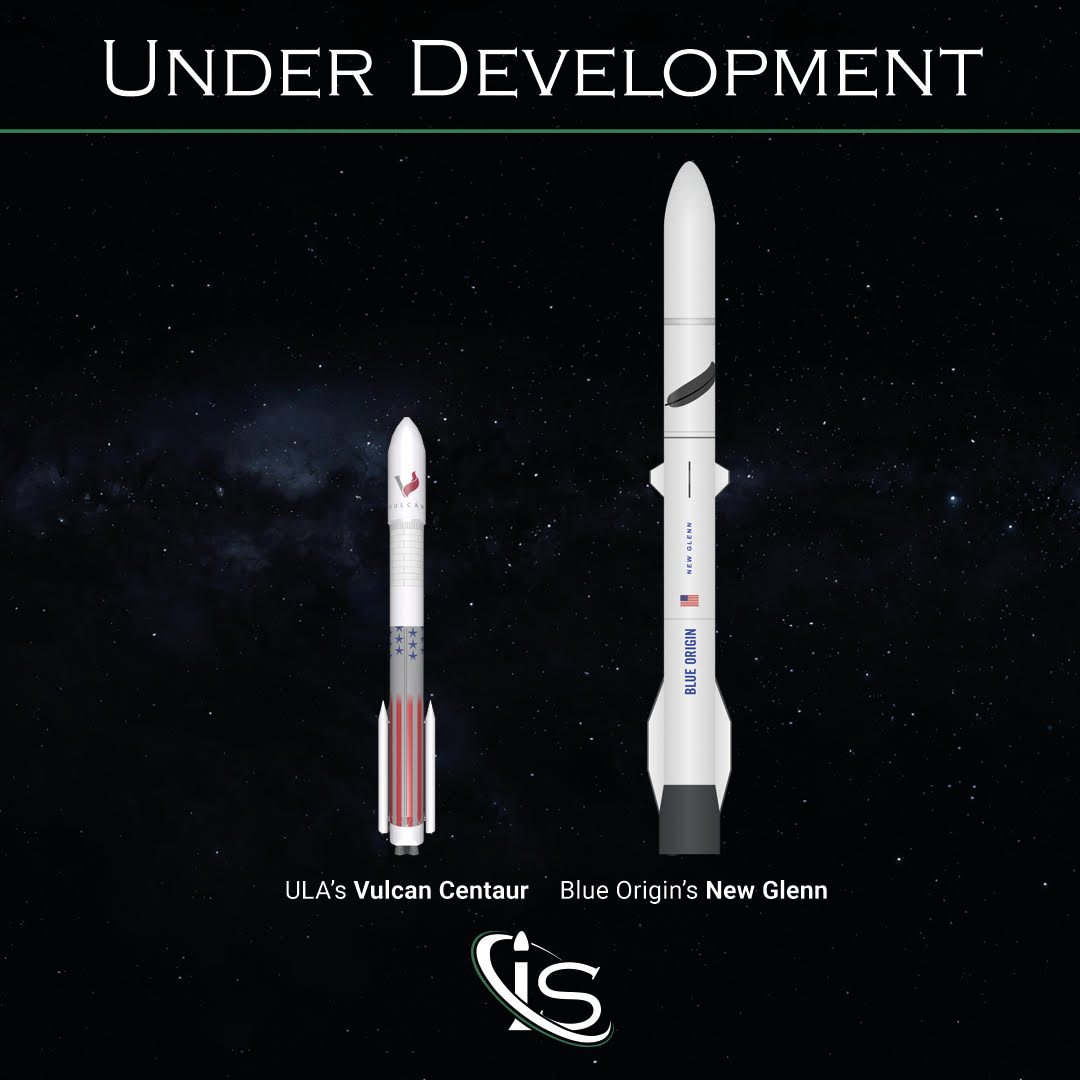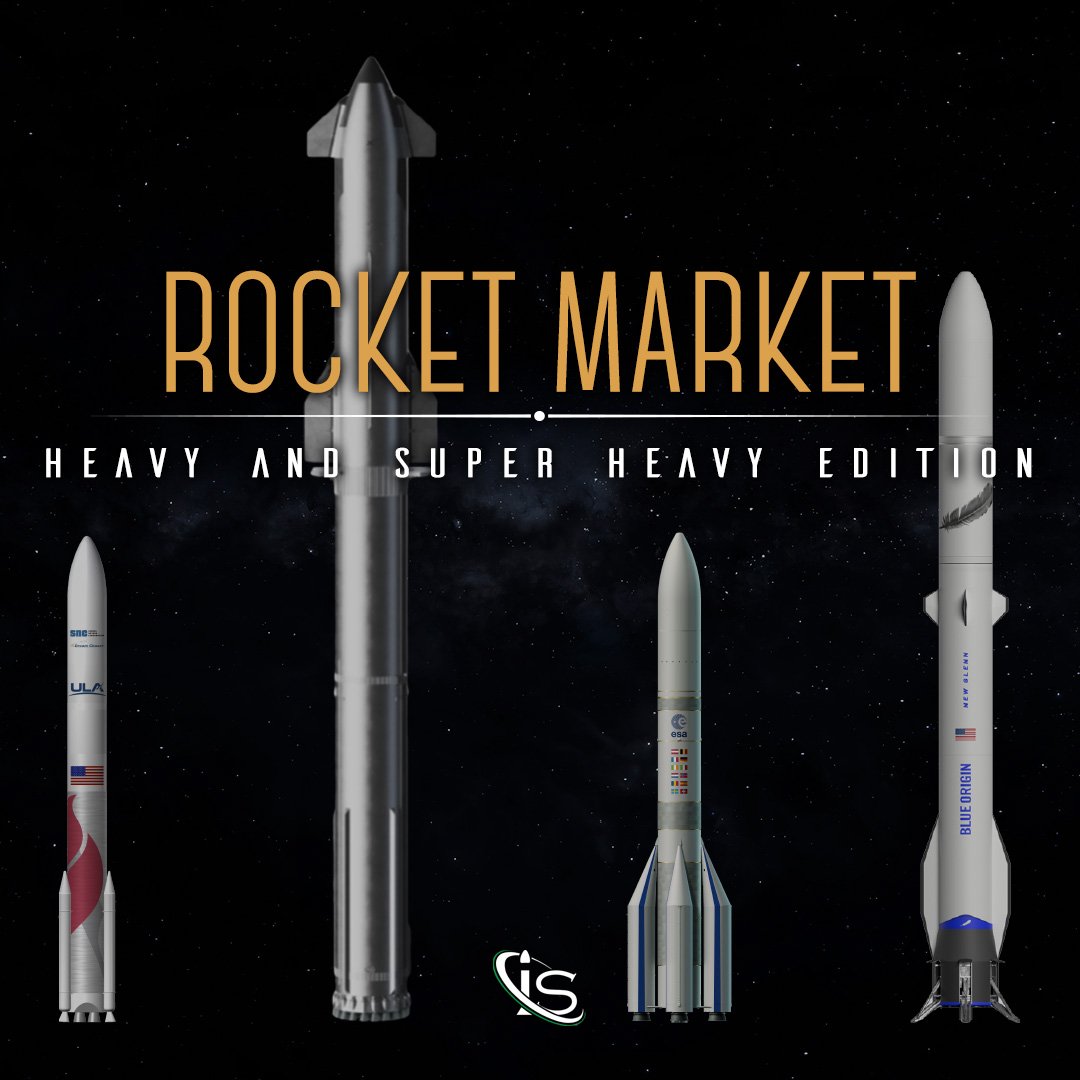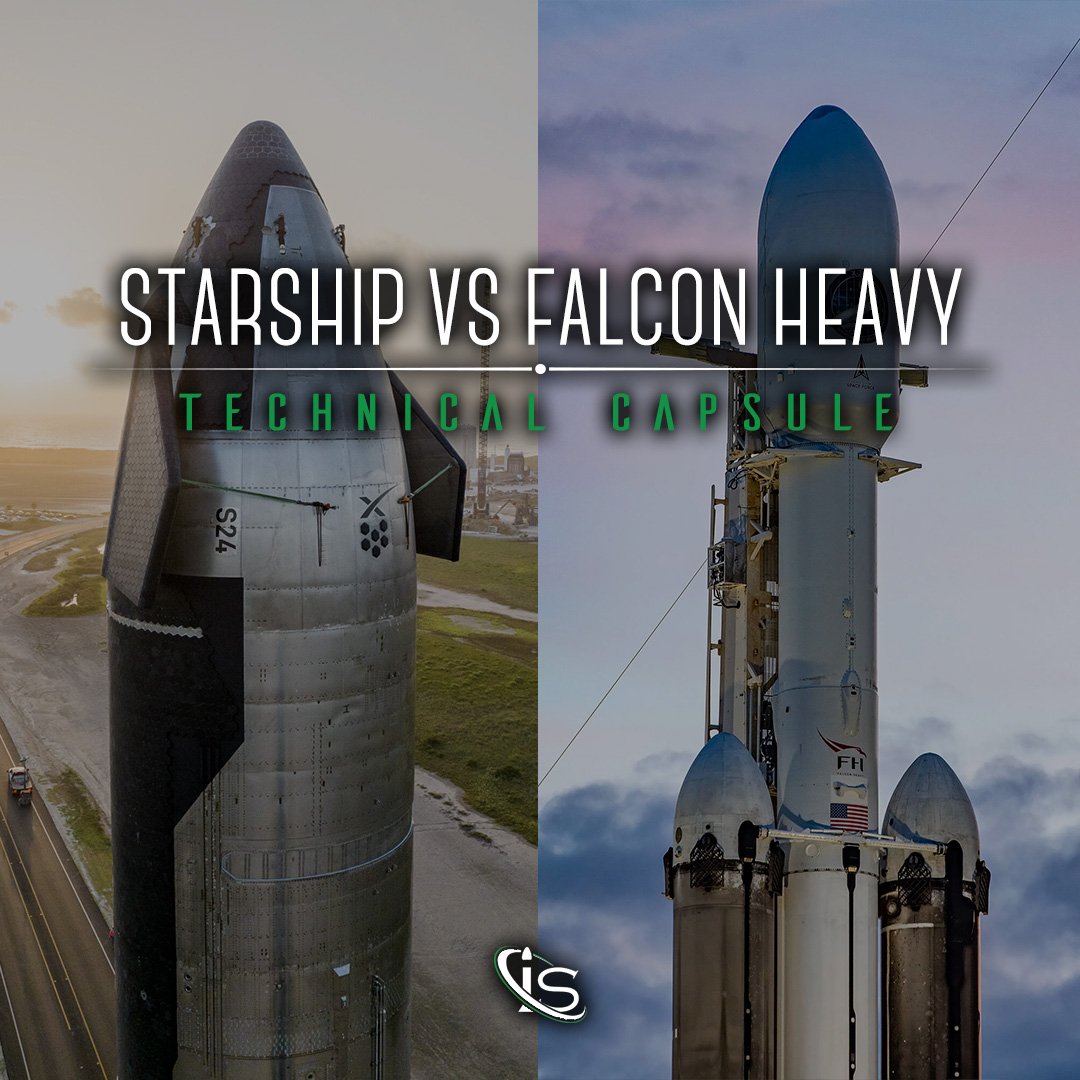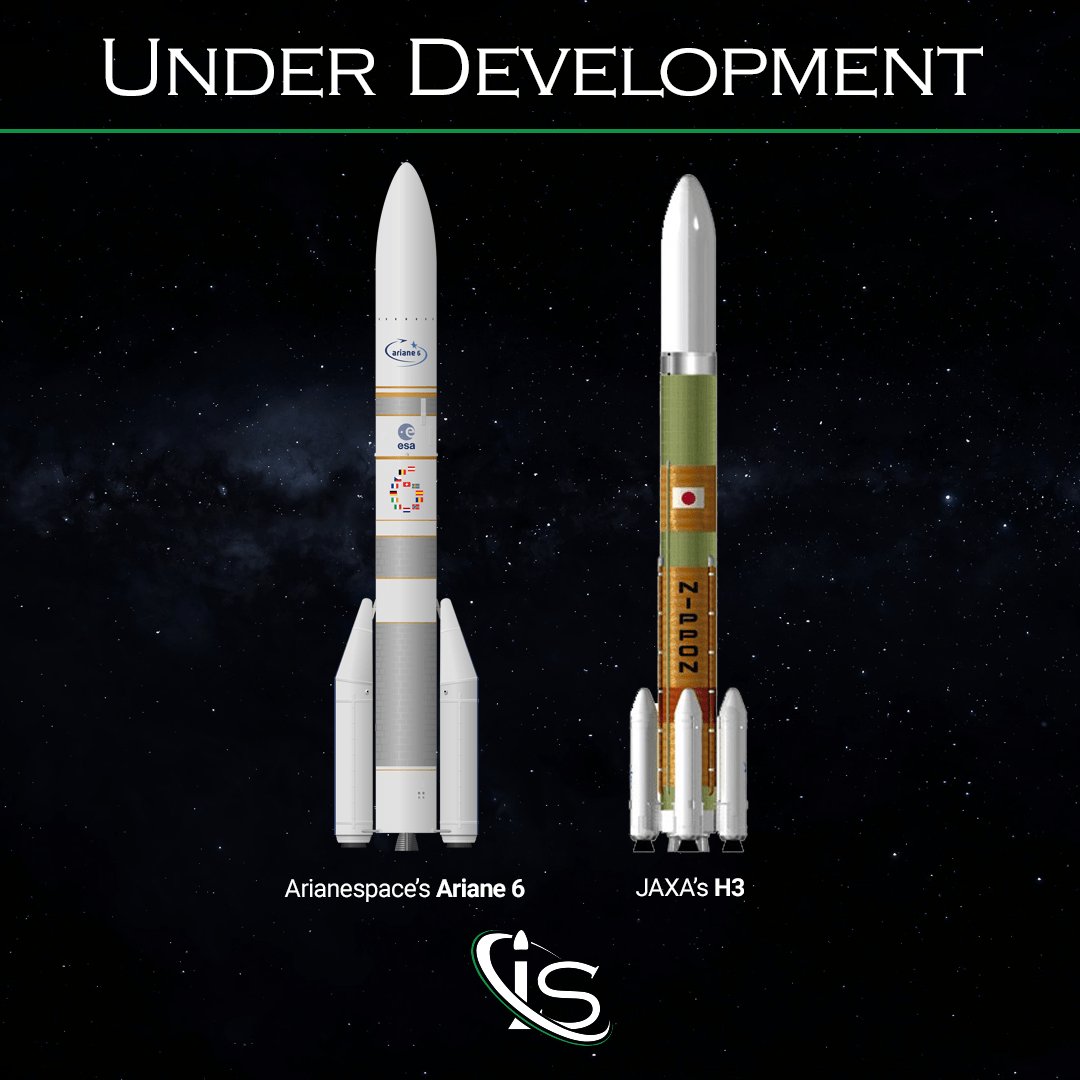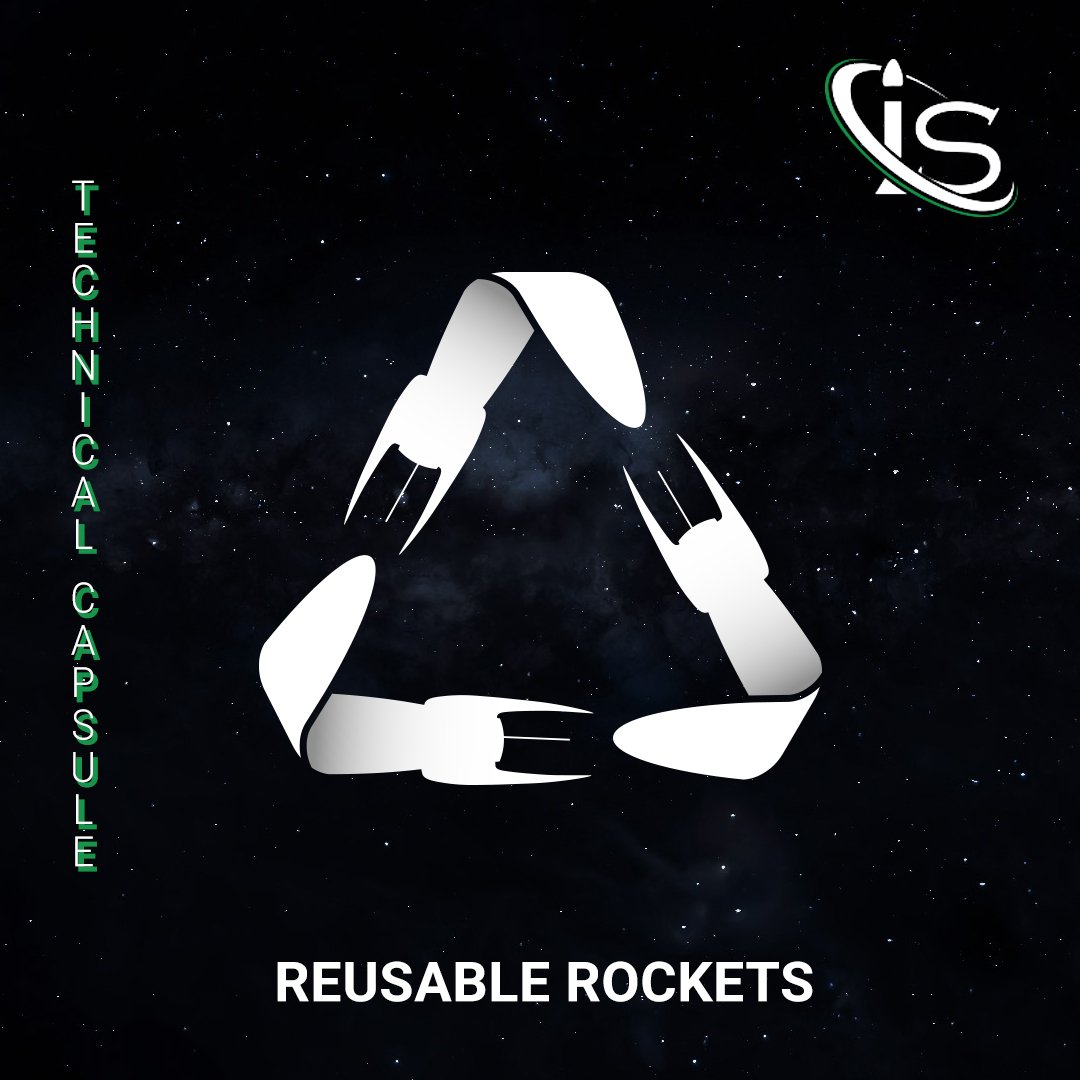The Super-Heavy Rocket market has been heating up in recent years. New rockets and new operators are emerging, while historic rockets are ending their illustrious careers. But such is the life of a rocket. Old ones will always end up making way for their new counterparts. Just like what happened in the past with the Space Shuttle, a cycle ends, and new protagonists appear.
Today’s capsule is centered particularly around the Western rocket market. However, if you would like an article dedicated to the Eastern one, simply leave a comment in our Chatbox, and we will give you all the information you desire.
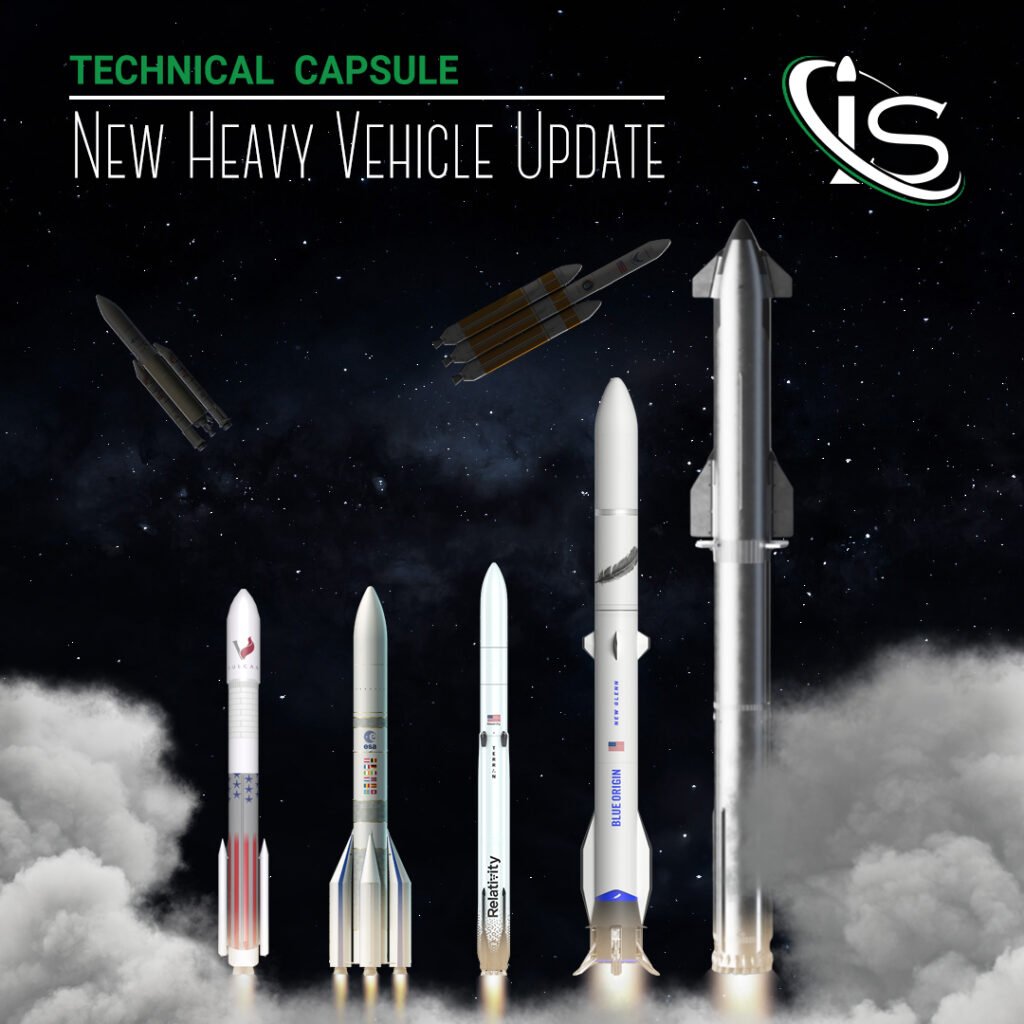
What Is Going on with the Active Heavy Launch Vehicles at the Moment?
Whoever had the chance to catch a livestream of the heavy rockets that launched recently, probably asked themselves this question. In fact, the two heavy rockets that are currently active are about to have their last launch.
For example, Ariane 5 — after launching its penultimate mission, JUICE — is about to perform/has just performed its final launch. Along these same lines, ULA has just launched the penultimate Delta IV Heavy, on June 22nd.
These events — as all space enthusiasts will agree — represent the end of an era. These two rockets have been THE market for heavy rockets for over 20 years. Ariane 5 launched 117 times in the last 27 years, while Delta IV “only” had 15 launches in 19 years.
At this point, some of you have probably thought: Falcon Heavy is still active. Why is it not being mentioned. And you are absolutely right to ponder that. Falcon Heavy — as its name suggests — is a heavy rocket. In fact, both in its expendable stage 1 configuration and its fully expendable one, it is a super heavy rocket! So, why was it not included before? The reason is simple. It still has not carried a large enough payload to place it into either the heavy or super-heavy categories.
New Protagonists Incoming…
We have been talking about these new protagonists for a while now. So, this will just be a way to revisit them altogether. However, I am not sure that all of them are widely well known. Therefore, we would like to tell you a bit more about each one. Let us start with what stage of development they are at, and when their maiden flight is scheduled to happen.
SpaceX’s Starship
We have talked at length about this rocket in previous articles. There are articles dedicated to its updates and ones comparing it to the SLS and Falcon Heavy.
What we care about the most here is at what point in the development cycle this rocket is. And, when can we expect the next launch. As many of you are aware, the first launch attempt happened on April 20th, 2023 and resulted in a failure. As a result, SpaceX is already working on the next iteration of Starship, which will be comprised of the Booster 7 and Ship 25. The static fire for SH25 went off without a hitch, on June 26th.
SpaceX has not released an exact date for the second test. However, as these tests are currently underway, we can expect the next launch to happen before the end of the year.

For the technical details of this rocket, we suggest checking out the post “SLS vs Starship“
ULA’s Vulcan Centaur
At the time of writing, the date for Vulcan Centaur’s maiden flight has not been released. It is well known, however, that this launch could have on board the Peregrin mission, which has the Moon as its target. Just like with a piggyback, there will be two test satellites for the Kuiper constellation and one for the company Celestis. The configuration for this first Vulcan rocket is planned to include two lateral boosters and a standard-sized fairing.
After the arrival of the first stage engines — the BE-4 — ULA has made huge strides forward with the testing of this component. This month saw a successful “Engine Firing” test. In its current version, the first stage is ready to support the maiden flight of Vulcan Centaur.
Even with these promising results, however, the first stage has been removed and laid horizontally once again. The reason is tied to an anomaly with the upper stage, which led to the return of it to Decantur, Alabama, for new examinations.

For the technical details of Vulcan Centaur, we suggest checking out the post “Vulcan Centaur and New Glenn“
Arianespace’s Ariane 6
Over the past few days, the first image of Ariane 6 standing on the pad of Kouros has been making its rounds on social media. Even if it is not (yet) on the pad for the launch, the emotion of seeing it fully assembled was quite intense! The rocket has the role of testing the assembly procedures, the connection of the propellant, and the electricity and telemetry.
In the next few months, we will continue to follow the other tests on this rocket. Until the fateful day of the true “Launch Vehicle Assembly”, which is scheduled for November, 2023.
Ariane 6 has been in development since the early 2010’s, and its maiden flight was, originally, scheduled for 2020. However, it has since been moved to no earlier than 2024’s Q2.

For the technical details of Ariane 6, we suggest checking out the post “Ariane 6 and H3“
Blue Origin’s New Glenn
As for New Glenn’s development, the informations on it are few and hard to find. Still, we know that the first stage will be equipped with the same engine of Vulcan Centaur. An engine that was designed by Blue Origin, itself. The BE-4’s that will power the first stage have, therefore, already been tested successfully by ULA. We also know that there are tests upcoming for Blue Origin’s pad, SLC-16, but no further details are available about this.
Other than the engines, the only information that has been released is on the advancement of the Vertical Assembly Building and Reef Pathfinder. The latter will be a space station realized by Blue Origin with the collaboration of Sierra Space. This will be placed in orbit, and, subsequently, refurbished by New Glenn.
The maiden flight is scheduled for the end of 2024, so there is still some time before we can get more “juicy” news on this rocket.

For the technical details of it, we suggest checking out the post “Vulcan Centaur and New Glenn“
Relativity’s Terran R
Terran R is the rocket which we, currently, know the least about. This is because its maiden flight is the farthest away, with the tentative date being 2026.
What we do know with certainty is that, after Terran 1’s failed launch this March, Relativity canned that project to focus solely on Terran R. In the past few months, the rocket has been completely revisited. For example, the fuel tanks that they had previously thought of 3D-printing — like the rest of the rocket — will instead be produced in the traditional way in an aluminum alloy.
We await with intrepidation the moment that more news will arrive about this rocket. So, we will see you all when we have some more interesting updates for it.

Comparison
Now that we introduced the future protagonists of the heavy rocket market, we can do a quick discussion on what each rocket’s main ambitions are, as well as their differences.
Fairing
Let us start from the top with the rockets’ fairing. This is usually second to the technical details of the engines. However, we still think it is of great importance, and something worth going in depth about.
Scouring the web, we ran into a couple telling images, which will no doubt help support this section.
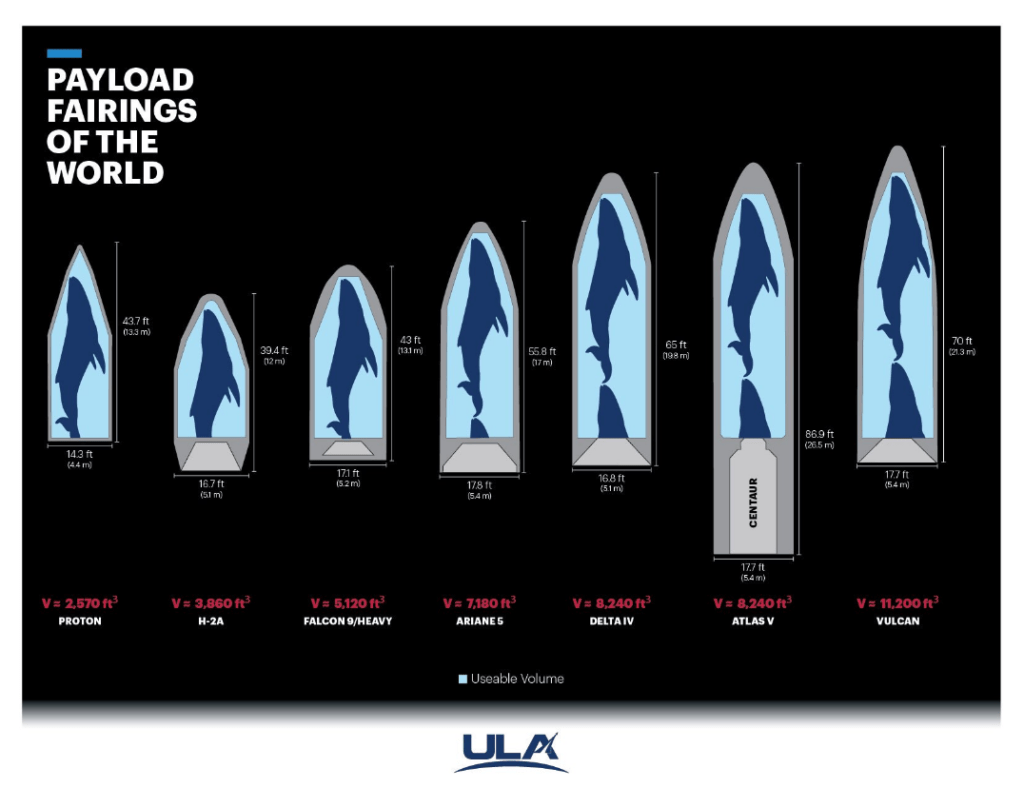
Combining these two pictures together — the first from Relativity and the second from ULA — allows us to compare the rockets, yes, but also observe how their fairing’s dimensions will differ from those of the old guard. If we focus on the first image, we can see how Ariane 5 and Delta IV have a higher capacity than Falcon 9. This, of course, is due to the latter being a medium rocket. Ariane 5 has a volume of 203 m3 (7.180 ft3), while Delta IV has one of 233 m3 (8.240 ft3). This makes Delta IV’s volume the equivalent of 1.33 whales. The new ULA rocket, on the other hand, will have a fairing with a much higher capacity of 317 m3 (11.200 ft3). This corresponds to over 27 tons in LEO.
The Fairing’s Capacity
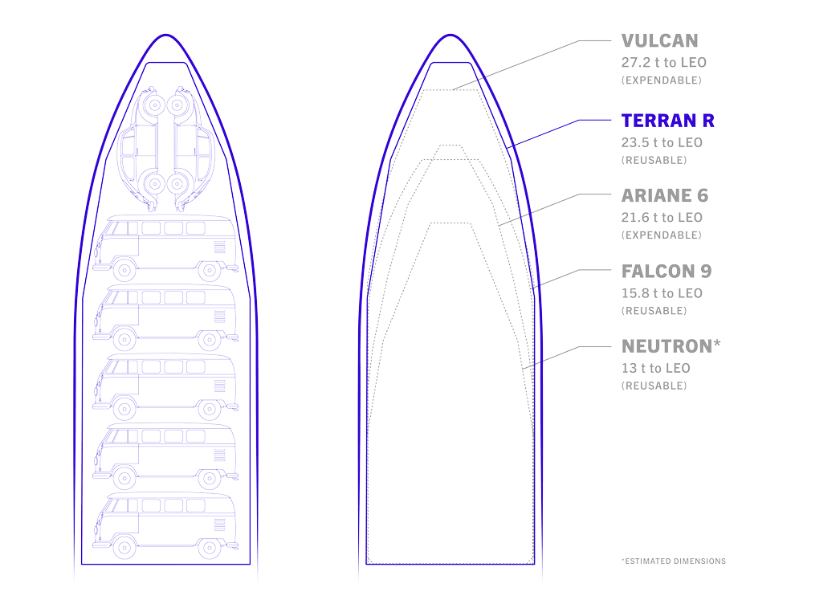
With the second picture, we can compare the capacity that each rocket can carry to LEO. Falcon 9 — which has a fairing that is circa 50% smaller than that of Vulcan Centaur — has a capacity of 60% in its reusable configuration. As for Terran R, in terms of the fairing’s dimensions, it is larger than both Vulcan and Falcon 9.
A separate point has to be made for Starship, whose Ship will include the fairing. That means that it will not have a “proper” fairing like the ones we have seen so far.
The following table shows a recap of the characteristics and capacities of each rocket’s fairing.
| Fairing Envelope | Capacity to LEO | |
| Starship | 100 – 150 t | |
| Vulcan Centaur | 317 m3 | 27.2 t |
| Ariane 64 | ~ 300 m3 | 21.6 t |
| New Glenn | 45 t | |
| Terran R | 23.5 t |
Reusability
The theme of reusability is near and dear to us. In fact, we dedicated a whole article to it, the “Reusable Rocket” one, which you can check out if you are interested in the topic. As for this capsule, we will quickly go over this point with the help of a table.
| First Stage | Second Stage | Fuel/Oxidizer | |
| Starship | ✅ | ✅ | CH4/LOX |
| Vulcan Centaur | ❌ | ❌ | Al-HTPB/AP, CH4/LOX, LH2/LOX |
| Ariane 6 | ❌ | ❌ | Al-HTPB, LH2/LOX |
| New Glenn | ✅ | ✅ | CH4/LOX, LH2/LOX |
| Terran R | ✅ | ❌ | CH4/LOX |
As you can see, so far, only SpaceX and New Glenn are working towards using reusable rockets. However, the other operators are also trying their best to make their machines be “greener”. For example, Arianespace is working towards a re-ignitable engine, VINCI, for the upper stage. That way, this part could de-orbit autonomously and, subsequently, burn up in Earth’s atmosphere.
As for the pollution side of things, this was also discussed at length in another article, aptly named “Rocket Pollution“. There, we can see how every rocket is going towards a less polluting propellant solution, such as methane and liquid hydrogen.
This discussion focused on the Heavy and Super-Heavy rockets. However, great changes have been happening for Small and Medium spacecrafts, as well. So, feel free to let us know if you would like to learn more about that.
I hope you are ready for next week’s capsule. We will be comparing one of the rockets we discussed today with the historic Saturn V. And so, we will “see you” right here same time, same place, next week. A good day to all of you from us at impulso.space.

